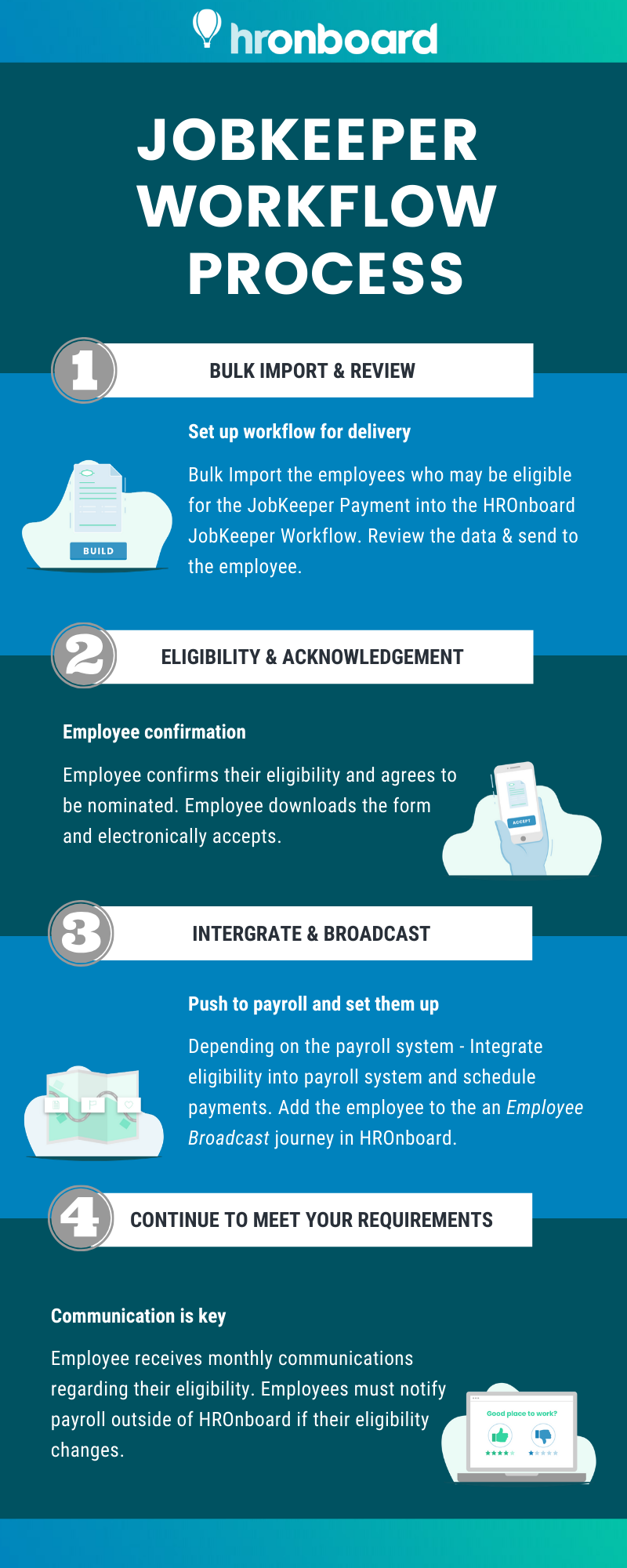JobKeeper Payments: A Guide For Employers & How We Can Help
Since the JobKeeper payment scheme was announced there has been some confusion for businesses, especially large-scale enterprises, about how to implement the initiative for their employees while meeting compliance and business requirements.
Within days, businesses need to work out how to communicate at mass with their workforce, meet their obligations, and then submit their intent to claim to the ATO before the end of April.
Over the past week, we’ve listened to our community – asking one question – “How can we help?” We’re process & experience people – challenges like this are our jam!
We know you’re digging deep in the face of adversity and want to make this happen quickly to support your business and employees, and you shouldn’t face this alone. That’s why we built the JobKeeper Workflow – compliant, effortless and configured for you within hours.
What do employers need to do?
First up, you will need to determine if your business is eligible to receive the JobKeeper payment. You will find information on the ATO website about eligibility criteria and how to calculate a downturn in turnover. We recommend registering to receive updates on the JobKeeper Payment at the ATO so that you can stay informed about any changing obligations.
Enrolling for the JobKeeper Payment must be done by the end of April if you intend to claim the JobKeeper payment for your eligible employees for April. You will need to enrol for JobKeeper payments with the confirmed employee forms for the fortnight of ‘30 March – 12 April’ and the second JobKeeper fortnight ‘13 April – 26 April’ by then. It is the responsibility of the business to declare the eligible employees within the specified period and provide all supporting information to the ATO.
We can help you with the process to determine which employees are eligible for the payment. Start with the employees you know are eligible & notify them of your intent to nominate them for the JobKeeper payment scheme. From the 30th of April, you must have your eligible employees confirmed in order to receive the payments.
It was easy to read and to complete. Thank you very much. Me and my family really appreciate your help during the Covid-19
Determining Eligible Employees
How to determine who may be eligible
Start by determining who is not eligible – rule out people based on employment dates, employment status, age, and work rights (residency/citizenship) etc.
This will leave you with a pool of people who may be eligible – if they agree to be nominated by you, they become eligible employees.

Your employee is eligible under the JobKeeper Payment scheme if they:
- are employed by you (including those stood down or re-hired)
- were either a
- permanent full-time or part-time employee at 1 March 2020
- long-term casual employee (employed on a regular and systematic basis for at least 12 months) as at 1 March 2020 and not a permanent employee of any other employer
- were at least 16 years of age on 1 March 2020
- were an Australian resident as at 1 March 2020 within the meaning of the Social Security Act 1991, which requires that they reside in Australia, and are one of an Australian citizen, the holder of a permanent visa, or a Protected Special Category Visa Holder. More information about these requirements can be found from the Services Australia website under residence descriptions. Your employee can also be an Australian tax resident who is a Special Category (Subclass 444) Visa Holder. Employees who are not permanent residents of Australia must notify you of their visa status to allow you to determine if they are eligible.
- were not in receipt of any of these payments during the JobKeeper fortnight
- government parental leave or Dad and partner pay
- a payment in accordance with Australian worker compensation law for an individual’s total incapacity for work
- agree to be nominated by you (see Nominating employees).
Confirming who is eligible
Notify the people who may be eligible of your intention to nominate them for the payment. You must provide them with the employee nomination notice form to complete.
The Employee must complete, sign and return this form. Within the form, they must choose whether they agree to be nominated or not. The onus is on the employee to confirm they are eligible.
If they agree to be nominated within the form, they are confirmed as an eligible employee. If they do not agree to be nominated, you can not claim the JobKeeper payment for them. All employees must have their nomination form confirmed and returned to their employer to receive JobKeeper payments.
Outstanding work by the HR team, thank you for all your efforts
Your Ongoing Requirements
Each month employers must reconfirm their eligible employees with the ATO in order to continue receiving the payment. Currently, there are no clear guidelines on how to do this.
A suggested way to handle this:
- Communicate with your eligible employees each month.
- Let them know you are continuing to claim the JobKeeper payment for them, and what the eligibility requirements are.
- Instruct them that they must notify you if their eligibility changes.
What does it look like in HROnboard?
We can use the JobKeeper workflow to help with getting the employee to confirm, using the ATO nomination form, whether they are eligible and whether they agree to be nominated. This will also create an audit trail to report on any future compliance needs that the JobKeeper scheme might require.Ongoing communications to confirm eligible employees can be managed through the new Employee Broadcasts module in HROnboard. Due to the nature of the JobKeeper initiative, you can easily download a list of all employees and filter by eligibility making it easy to manage and notify your workforce when re-establishing the commencement of regular trading.
Enabling A Smooth Transition
It’s not an easy feat for companies that have skeleton staff working around the clock to keep up with the changing economic landscape. Companies are pivoting harder than Ross from Friends in an attempt to stay afloat financially and keep workforces employed. Making the transition to JobKeeper payments for staff as easy as possible will mean that businesses have the space to focus on keeping themselves viable in the near future.
The feedback from leaders and employees going through the JobKeeper journey speak for themselves. Giving them the peace of mind that they need right now – knowing that food will be on the table over the next few months – is not about employee engagement but simply caring about your employee community.
Reading comments like these highlights the importance that these critical moments have on the health and wellbeing of your community.
Need to rapidly introduce a JobKeeper workflow to your team? Whether your new to HROnboard or one of our wonderful existing customers, please reach out to us. We’re here to help.

